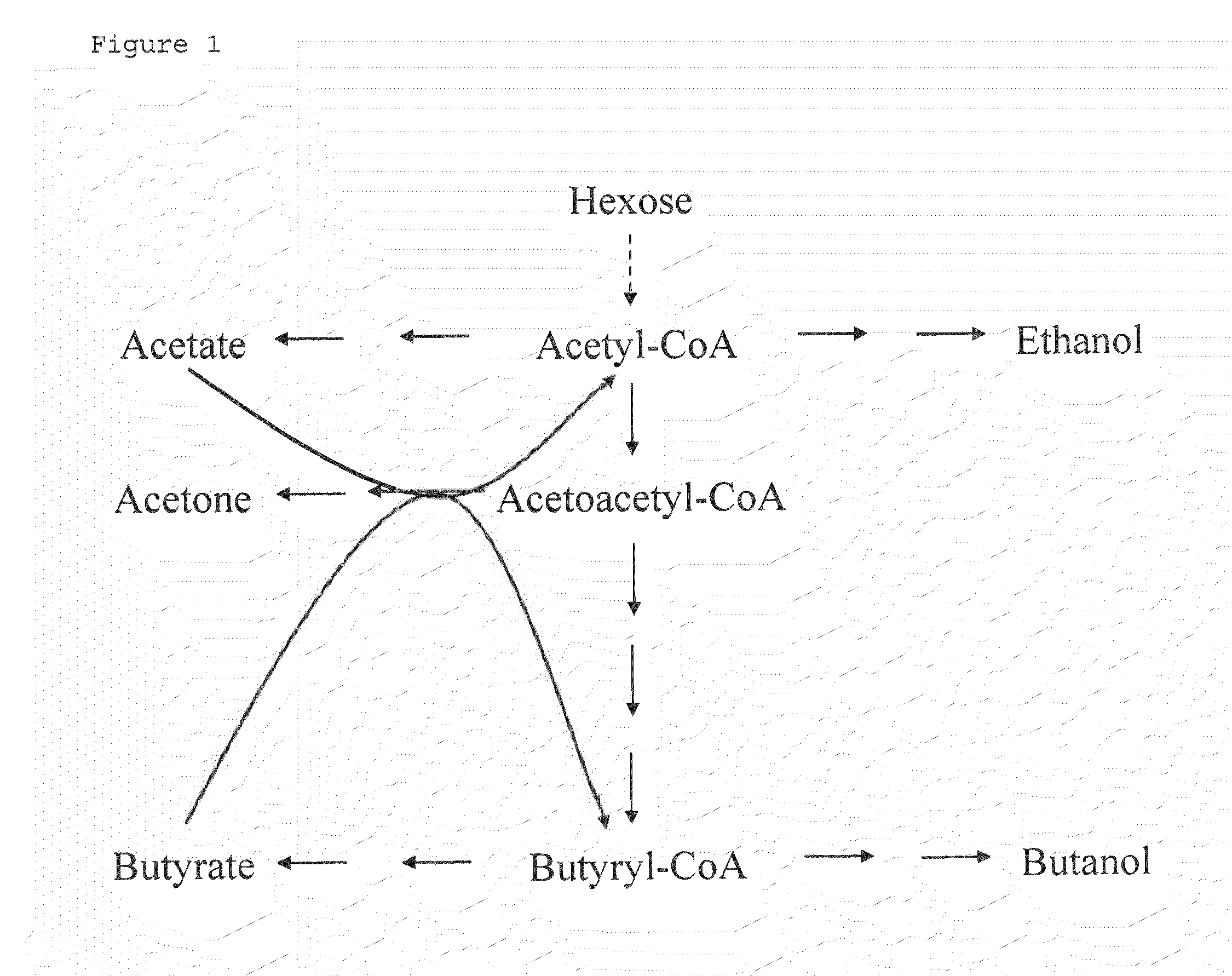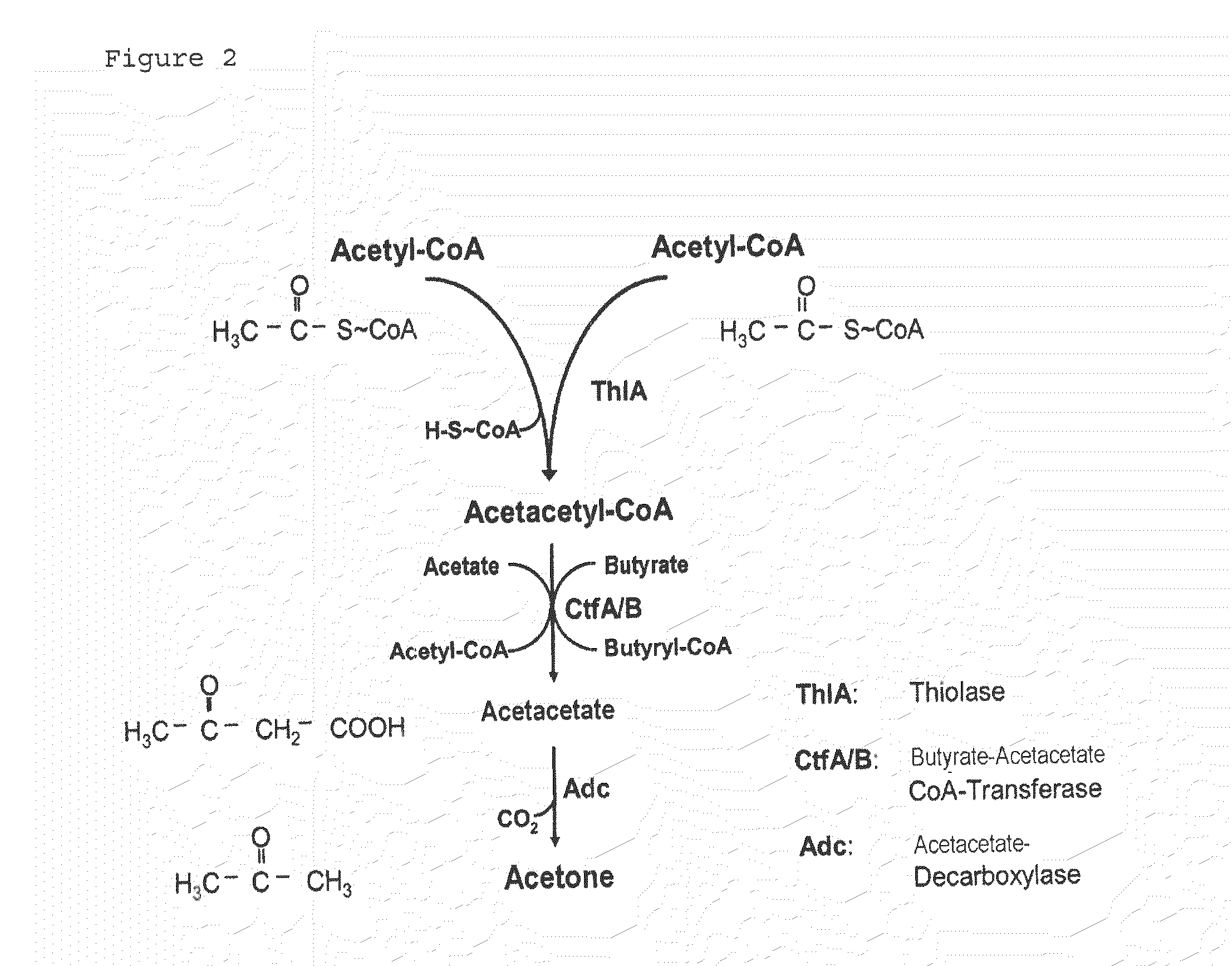Fermentative production of acetone from renewable resources by means of novel metabolic pathway
- Summary
- Abstract
- Description
- Claims
- Application Information
AI Technical Summary
Benefits of technology
Problems solved by technology
Method used
Image
Examples
example 1
Thioesterase II (TEIIsrf) from Bacillus subtilis
[0098]This enzyme is associated with the non-ribosomal peptide synthetases for the formation of surfactin (peptide antibiotics) in B. subtilis ATCC 21332. Schwarzer et al. were able to clone the corresponding gene into the plasmid pQE60 which mediates fusion of the target protein with a C-terminal His tag (pTEIIsrf) and purify the protein (28 kDa) (Schwarzer D., H. D. Mootz, U. Linne, M. A. Marahiel. 2002. Regeneration of misprimed nonribosomal peptide synthetases by type II thioesterases. PNAS 99:14083-14088). In subsequent investigations, a hydrolytic activity with acetyl-CoA and propionyl-CoA as substrates was demonstrated for this protein.
[0099]The plasmid pTEIIsrf with SEQ ID No. 13 was prepared as described in Schwarzer D, Mootz H D, Linne U, Marahiel M A. Regeneration of misprimed nonribosomal peptide synthetases by type II thioesterases. Proc Natl Acad Sci USA. 2002 Oct. 29; 99(22):14083-8.
[0100]The expression of the protein t...
example 2
Acetoacetyl-CoA Synthetase (AACS) from Sinorhizobium meliloti
[0105]The acetoacetyl-CoA synthetase (AACS) having amino acid sequence SEQ ID No. 3 and corresponding cDNA sequence SEQ ID No. 4 from S. meliloti catalyses the conversion of acetoacetate and coenzyme A with consumption of ATP into acetoacetyl-CoA and AMP. However, in the framework of the present invention, the reverse reaction was of interest.
[0106]The corresponding gene acsA2 was cloned into the expression vector pET30 Xa / LIC as disclosed in Aneja, P., R. Dziak, G.-Q. Cai, T. C. Charles. 2002. Identification of an Acetoacetyl Coenzyme A Synthetase-Dependent Pathway for Utilization of L-(+)-3-hydroxybutyrate in Sinorhizobium meliloti. J. Bacteriol. 184:1571-1577. The plasmid “pRD112” obtained in this way mediates N-terminal fusion of the target protein to a His tag which in turn makes purification possible by affinity chromatography on Ni2+-NTA agarose.
[0107]The protein was expressed in E. coli BL21 (DE3) cells at 37° C. ...
example 3
Acyl-CoA Thioesterase YbgC from Haemophilus influenzae
[0110]The YbgC protein with amino acid sequence SEQ ID No. 5 and corresponding cDNA sequence SEQ ID No. 6 from H. influenzae shows similarities with a corresponding protein from E. coli, the latter as cytoplasmic protein belonging to the so-called Tol-Pal system. This is widespread in Gram-negative bacteria. It is important for maintaining cell wall integrity and possibly has a function in the transport of substances through the periplasm. The function of YbgC in H. influenzae and any relations to functions of the Tol-Pal system have not on the other hand been published to date. However, the publication by Zhuang et al. (2002) describes investigations of the catalytic function of this protein and analysis of a thioesterase activity. It was possible to show in this case the hydrolysis of short-chain aliphatic acyl-CoA esters such as, for example, propionyl-CoA and butyryl-CoA (Km values 11-24 mM) by YbgC (Zhuang Z., F. Song, B. M...
PUM
| Property | Measurement | Unit |
|---|---|---|
| Fraction | aaaaa | aaaaa |
Abstract
Description
Claims
Application Information
 Login to View More
Login to View More - R&D
- Intellectual Property
- Life Sciences
- Materials
- Tech Scout
- Unparalleled Data Quality
- Higher Quality Content
- 60% Fewer Hallucinations
Browse by: Latest US Patents, China's latest patents, Technical Efficacy Thesaurus, Application Domain, Technology Topic, Popular Technical Reports.
© 2025 PatSnap. All rights reserved.Legal|Privacy policy|Modern Slavery Act Transparency Statement|Sitemap|About US| Contact US: help@patsnap.com



